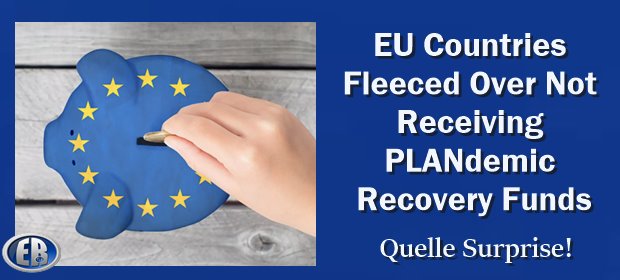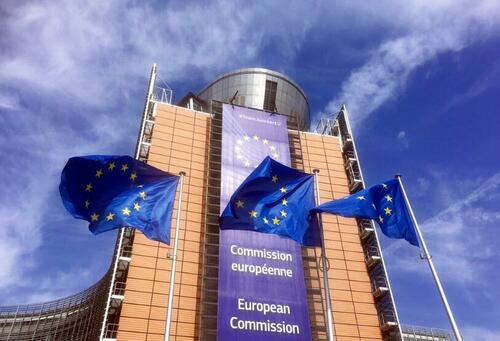
ER Editor: More ‘news’ which destroys the credibility of the EU. More evidence of the need for Brexit-type moves.
Recall Hungary may leave EU – former banking chief

The scenario below simply outlines why reasons for getting countries into debt (choose your reason) translate into policy arm-twisting against supposedly sovereign nations, and debtors take their profits from the taxpayer. “Oh dear, our original calculations are totally off because of increasing interest rates!”
********
Nine EU Countries Have Still Not Received Any Money From The COVID-19 Recovery Fund
The release of money is being held up due to bureaucracy and political pressure, while interest on the loans used to finance the fund has spiked dramatically…
As many as nine EU member states have yet to receive a cent from the Recovery Fund created by the European Union to provide financial aid to countries following the coronavirus pandemic.
The Recovery Fund was supposed to be a quick injection of funding for EU economies in the aftermath of the pandemic; however, just €150 billion of the €800 billion aid package has been distributed across the bloc to date, reaching just 18 countries.
In Brussels, it is increasingly heard that the implementation of some investments before the expiration of the Recovery Fund in 2026 may prove impossible.
To receive money, a country must submit a payment request to the European Commission. However, this is only possible after achieving so-called milestones for a given tranche after meeting specific investment conditions. In the absence of their fulfillment, the European Commission blocks the payment.
This happened in the case of Italy, which, according to the Commission, has problems with fulfilling commitments. Rome received two installments of funds, but a third installment was frozen by the Commission because the so-called milestones were not met.
Some EU countries have already submitted revised investment plans to the Commission, and officials in Brussels assume that others will join them in the coming weeks. The Commission promises to do everything it can to issue an assessment on their case as soon as possible.
So far, not a single euro from the Recovery Fund has been received by Poland, Germany, Hungary, Estonia, Sweden, Finland, the Netherlands, Belgium and Ireland.
“As a result of the war in Ukraine, there has been massive inflation, energy price hikes, and the cost of living for the average EU resident has increased. Meanwhile, the European Commission, in its plans concerning the Recovery Fund, did not take into account such a scenario at all (ER: sure it did),” said Poland’s Law and Justice (PiS) MEP Bogdan Rzońca, a member of the European Parliament’s budget committee.
“Some of the goals that the Commission set for the EU were unachievable from the start,” he added. (ER: Bingo)
In his opinion, funds should have simply been allocated to those areas that suffered the most as a result of the pandemic, for example, toward improving healthcare, fighting unemployment, and assisting businesses. “There were simple solutions, but the Commission went for unrealistic ambitions,” he said.
This is not the only trouble for Brussels. To finance the Recovery Fund, the European Commission borrowed on behalf of the EU via the capital markets. The problem now is the sharp increase in the cost of servicing these loans, which are covered by the EU budget for 2021-27. (ER: So the capital markets take their cut.)
When the fund was established, it was assumed that the average interest rate would gradually rise from 0.55 percent in 2021 to 1.15 percent in 2027. As a result, €14.9 billion was allocated in the 2021-27 budget for the repayment of interest on Recovery Fund loans.
Meanwhile, rates are significantly higher today.
This means that the €14.9 billion will be used up by the summer of 2023, more than four years ahead of the original plan.
“Simulations show that loan servicing costs will reach €34 billion for the period 2021-2026,” revealed the Commissioner for Economy Paolo Gentiloni (globalist) at a recent meeting of the European Parliament budget committee.
************
Source
Featured image source: https://www.bruegel.org/blog-post/will-european-union-countries-be-able-absorb-and-spend-well-blocs-recovery-funding

••••
The Liberty Beacon Project is now expanding at a near exponential rate, and for this we are grateful and excited! But we must also be practical. For 7 years we have not asked for any donations, and have built this project with our own funds as we grew. We are now experiencing ever increasing growing pains due to the large number of websites and projects we represent. So we have just installed donation buttons on our websites and ask that you consider this when you visit them. Nothing is too small. We thank you for all your support and your considerations … (TLB)
••••
Comment Policy: As a privately owned web site, we reserve the right to remove comments that contain spam, advertising, vulgarity, threats of violence, racism, or personal/abusive attacks on other users. This also applies to trolling, the use of more than one alias, or just intentional mischief. Enforcement of this policy is at the discretion of this websites administrators. Repeat offenders may be blocked or permanently banned without prior warning.
••••
Disclaimer: TLB websites contain copyrighted material the use of which has not always been specifically authorized by the copyright owner. We are making such material available to our readers under the provisions of “fair use” in an effort to advance a better understanding of political, health, economic and social issues. The material on this site is distributed without profit to those who have expressed a prior interest in receiving it for research and educational purposes. If you wish to use copyrighted material for purposes other than “fair use” you must request permission from the copyright owner.
••••
Disclaimer: The information and opinions shared are for informational purposes only including, but not limited to, text, graphics, images and other material are not intended as medical advice or instruction. Nothing mentioned is intended to be a substitute for professional medical advice, diagnosis or treatment.






Leave a Reply